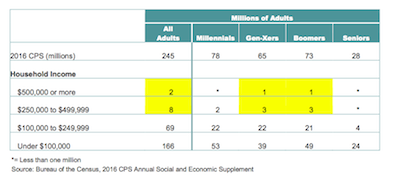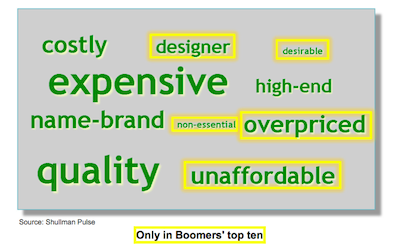While some themes regarding luxury goods are important to all age demographics, there are many that vary from generation to generation, making it important for brands to adjust their messaging.
A new report from Shullman Research Center shows that millennials make up half of adults who have purchased luxury items within the past year. Within the survey, words such as money, rich, best and classy made the top of the list for themes important to them when buying luxury goods.
“The key takeaway is that luxury marketers need to customize their messaging depending on the generation or generations they are targeting,” said Bob Shullman, founder/CEO of Shullman Research Center.
Shullman Research Center surveyed five groups, totaling 1,690 respondents that make up various income groups from $75,000 to $500,000 a year or more.
Generational gaps
To cater to the younger demographic, luxury marketers should focus on these themes important to them. Gen-Xers cited phrases such as unique, style, premium, exclusive and cars within the top 10.
Numbers of household income are showing that luxury markets should not focus solely on net worth, as the majority of luxury buyers make a household income less than $100,000 across all demographics. While these consumers are likely not purchasing high-end items as frequently as those with higher incomes, there are still a great number of them as possible customers.

Shullman chart
About 37 million consumers who make less than $100,000 are luxury buyers, while only 1 million of those that make more than $500,000 are.
When asked to describe words that come to mind when thinking about luxury, luxury buyers mostly responded with positive sentiments. Words such as expensive, name brand and quality topped the list.
However, two negative words, overpriced and unaffordable, appeared within the responses.
For baby boomers, the sentiment in regards to luxury seems to lean more toward the negative side, with the top description words being non-essential, unaffordable and overpriced.

Shullman word cloud
Additional insight
In a surprise twist for high-end marketers, it turns out that the majority of sales for luxury products come from Americans whose household incomes are less than $100,000 a year, according to an earlier report from Shullman research.
Many luxury brands think of themselves as catering to the affluent consumer with yearly salaries over $100,000, but research is showing that average Americans make up the majority of customers. While those with higher incomes spend larger amounts and buy more frequently, the average customer still makes a big impact for these brands, as they outnumber the affluent (see more).
Millionaires from the X generation hold onto traditional luxury events while millionaire millennials are straying away from happenings such as fashion shows and auto races, according to a new report from Shullman Research Center.
While there are vast differences in culture, behavior and values between lower income consumers versus millionaires, this also holds true for differing generations. For instance, family is the top priority in millionaire Gen-Xers’ lives with 89 percent believing so, but only 67 percent of millionaire millennials say the same (see more).
“We have found that there are specific luxury themes and benefits that really appeal to all the generations who buy luxuries, such as quality, and there are themes and benefits that appeal specifically to specific generations, such as classy for millennials, unique for Gen-Xers and designer for boomers, and, as such, not to all luxury buyers,” Mr. Shullman said.
{"ct":"N+0JmA0ZOqQJcEqsFvTmVJbmrylEVVxap9C5jKggnoWC+87rAMugbYen+ODK3depigAlcASHOhs3D7k6zHYR9u8XBecDjlXHZuZ5DO\/d4d4XthacoBPBywOrtVFiqmOj2zOHDny4FDlO1ZmoIAXt16Ql+ROezgg2\/A2gq\/O8sJsi0lFI8FXFGYKwZkPO8UrF+QOPQI7jVXzOyZbS04qekIcnj211Xz76t88uJpe8ynQvycYVXYQ2ihAx2vTO7r5BVa2AWToEwyGOKZZNBXms6cHIeg9ntptQg27tK3Q8jz6i7rybgYk8yQEgrk5AuSBf7W+CKCAS9wXx7X+MYbo5SwwynWEIqCkvFg7rgJI5G4pnQxVwuXWhZ48\/hLzfavd4uQKOvUEwWwoN61kc9EGsTu7YyC6udimYr138POftRsHLrrboxP+xGy7oNkLCGE8IVodtGybfATplSWo+RVf9EvoJNJoLCcJatw87E5LZw5s7SRrJZf\/UG1ZQxbfSzBGfPBHf+aYG6jSWJBfrW4C\/IJbjZovCe7eNlpH64bJuJTKvjmChB8Pnvhp7Q4eGaGj8dMalhBwHT+ukdqeyb0v9XPCJ8Cd23OKNUddMI26Hbvw3x40CqFNVUFtSi5ThP0+J5gW8gRUgV+MuW\/2\/wlVBVU5pxSOXrZpnmFF5AEMhs\/2jZIwahEKLxJDTHAiZBa99ZEx2xtXCRtiUUDWTmvX0S7c3Gh7Pf+bmfHSeCwtT6vlpgiSS0slOXvtkVWHtzrndUoqtQBTvngIH\/IPqOU9C4OxfG88J64AOo7QHKSpZ789XzoDU4xw8oONsBJKpAEfSsZcOOusW2FOq4cq2J39dvZuxKLahCI2opvr5zwa9PdWunZO15+Y4hp5NrDZ2V0zP4k4hej\/zuITKxXVxg\/dcVAW8cVa5QvKuChdieSt9x+d7EecaniTCGhiO69SgPSVqk67C6Ox+SuJA8oTnNn5viquaEly6cP212oyYNDwu3vwr+vJyZFbRCbyUVHxrq\/wnW\/fQd4RcJQs\/F4Lb30EGIgNjN3WwCSbRMsbLGpLktizFRdj8hQmfqf57VSiLAFrTMirNwRmmCumFu+or95ji0hlci+yME6TxJmaStvIyzhfbbRckNWjLbgScD9yF+M+PxwOz+k5USSQOB\/\/g3k+QDQC2hcVMLUPTeRmV7S\/A+5ELPCw7GcDEOA7NZ1qbOMwUrcDeyYgPdaNZUtsXWtyn17i2bLSJwL15KYCtremgpJMc8+6sSAfvRHxL0RM\/sGPTI0bBR8mEJrYuvqqz49PHWQYul\/LgPvlJjEwLUBdw3W0n6VmVKsXTLb25Nf70s1jt1ICJb\/3wkm1w9HsQXfmcIYOtln+grLvG9hgd3imwG4mguvZwOwAu1uf+DbJ\/q2zt+0w1WQijUIRfMyUjDu98\/kNUj0XsdF57EFFNhHGfaDN+4M2QOfZID3UEsOZMYFeR4cUNN+j91n2yuHU3xU89HwVw+PvJ4tt5LcS8F0Nd3x\/k18MBdhcgL10XfsVLXulPwSADKGfbiXFw\/tYvp1Cc03Uj10srX\/PK64xTomJdHT\/sSmNkR0y1uy5slo49TdCeL+ZB1D3bK0aNEqHDDPCmW0nCKwaerGscuzMkxruedjKhpXJw7crL9tqL5aOfmNBfPM+uKMTsqk8UOm0GHMPTTM3PoeHaE8kS0bfc\/SCCj63VgsarvijrV2tIKPVWpEb5HeVy2uerJqUwaWZp6+4wakUF\/uQjuVE9wgxsDFzSZ1JnWPsVb\/7\/OMNhJSkzoxoSDDS8Gb9TJTudrm1nr0F4f2z\/iwr99vfjsU\/aDjr4mZlOaul0auGjgYcMAbqvF9hjRMFRRU1u54lX1odCVZF3cN0hcc5l7jUoQ27bXQXUUadhodR4Td1qOs\/XeLOMFtOiNhodOKNKtYAqUWhbnF9hD4X132eWaelVSifFmfJOoRRy+CYdBv3Pux50EHVkyP\/3\/DS9W6pmENcTz7kRjbBlMvuioIaNvoUQ0qEgoNn1zPPeVavZDWCvM7rRT5DKw543TnCczhWgwU2TTpmeH3hTMkKbCB0SJQigAFLWZU5yNqtS8\/emKqijPo62Mmpa5\/Qj1C7695zbw0e6LXvsD\/Jqa8Ck+b95Tq0PkecGAmAoVKcMJFaFmLUSp1kSIWkGSF+wlPpqaNfbXLtfa\/XmUooN0UfCysKV1uULWHpuyteGHK7qt9wZ9TK9uEkCMFeejJVd\/Mz5FATQEvI2xaPT0E1LY7mtWpzyaDGEVKy80cbHECrPq3Z2Bf7lVwK3QtjRlF1nMEbhfp8RSACb3pambfZH5yHjK+Incx+nf8154XqCdgosIcaEuE2eQARwcQOMwMO7vEYm2MtLCruZxo8aPDdlWS+Yd+u1D569jpKSsXdOpWEefA1JWNeZ8842l5oiNc\/EhhLPGtIcpLksB4+1tvryR5MdZanlT8q1tPTk3qP5cdyO4pPBfTHd7cYcmQb9CYPDqwHMBg9tb0Wzn+cl3uBA2UPlpGHPDUeOcWiK6HQxx8oRM\/a5m2+wgySjUWe2gwJESpHwsZ0OMjEt478a8dJGlfCS34x3axEhETRzS7vqQ+NAytzyGyGjQWpx38sCNLWubnF+LGXpiWwo1QHc3Prlrm4uiJCqcJWtAcDLT6ZLhoXqhxDsaM6sEiMuwaXY5lU7NbnGfSsCCkbX9C01WcjqZe00b6sN1vbXEEo\/l2ZGeyeoWzRmghRhfTZqgKB47JN2xCM7ojC62dkmO0Y2aI9hf0xmS7Ap1jV39gP\/sLH3MICzk8E4ioO28Zf\/pPuRP8F9GulXw\/CIdQvK2y0hadx7u5P9FsD1xBIYv9H3\/xjxudfWsnu5toAzwLTuX6Aj6x2LeRj6vOg5BiY45Dv25RQPwGwVPu2BsEP1VLYlwszG2affyMQ59Cwq1gj3Jo3vigC7hAc61P0Kva86HNea1CRGQU+Wx0o3nb+Sb5vyWNcbZXOLMEqOwfgrCr67xTJ7rH\/6DiIN\/5Oj\/E93hjHvWobFrtL7yrEpzCtL44CDB7X5\/w1QLVDiFh3WZbjXIFfg2KnDalgaV69gsyb1y8TMykW8dghQXsYO10beYKUzp8s6C8ZL\/eJwSpM0DCliWMWlnjBzVdUGordxFfU3R3IbDZiQOjebmfM53kcPwqa96++IuhYD8a7Vwsg6e13oG7ZN0fpnO1AVwr+PmhnpxV1R3tTRfP2a3i9ZZUFysvVC7PQ\/TDl9Naer+GBRO4drUQvDFdZnKlqgTK+ZEAdZE3BMV\/1UTiywybS6x4gm77SoRePSjX7hS40By0B\/ADHEjiwXwSQ1\/Q11XSHZD9OtMtOFmJagYm59W3PzcqZwx5V\/qSZoqjjo3P7ZqLJsDPI7vaACzBi4M5QgGg7xGn8eKLzf\/goFkiP+asXdgSvSAoxEYCbMOfN2F+HnLx+WQBaL9ltPSizJxR8W5TKNaukrlRIZjr0dxZ+vzoUxMvqhOmUZ6NY6s2UgZ7JnnBbD4nGmhnYQQ1gbU21c6NgwDtuRW9aztWUKI4ziuIVwS4uarJWg\/2xZ4d\/SwMi63dG+c\/gYX3qCaVisjrQAwJiF6Z1oXiupFv87CokOnco+6NeF5BWznB0C8qY9AgBImd\/795JGvNoHb7EjOQHt+ZLbUVIKwh\/dLxWa39BxG1MPxyw726t1+JFQmzJxmiU75uJoNntJ7kIgT3++kxuD5YRWaVy1XjdMhmj\/\/WHb\/+jUjzrmrVRGaewN2LgBYjIHhNgkjHL\/Z25uRyrswrAbVlriTmgnwuEbCkaodWhafbFPwaw1p+yhpiK31RNwDMmVZBsYJeFDQNB6iLTwpEjW8QjVTqHU730eE5rdns7ai081N4a9Ke99BiTKcXRJS5pvQpUx5DCV2FpHhM0LcphNWDNisztrDF+JDHxF4OxjfSPEgBjZshoLCPZ8vwSm2fzDA4RzKATzhjyeRkcqw4F\/4B9e7OIJef8qZf8OmkARywjG0aGcopf02s7mAO8T2Sx\/1JGOIuUe3EN\/owwWP+SnTuDIzFnvEmZi3BiWsqZz0gjJg\/VCJxjRyvZjk0pk\/+hNgUp19gXrGd8yUUP6koW28w4UNf8E0RwmS\/oo5F8DIMrDasoR75JzicGouo81uURyDCb\/URnSz+y+FnMk2fMP2\/0TMlnxHcdAqNL6UagA7mBZLsFu\/EYtAiDQZ82Hvh+jU4YNHsgmsJo2Rqp2axBZFSIzH1hiNC+1RxRJUM+jMAAcUNHwDpyMCrBxlXi\/ojfbT0ZJtsrjL0zBcxNdxSvfyoUTs\/7jzzwkZuQW6nShWVB71PYmrxfJc0KiWdXe2mu4MF9asg58ErRu\/K0xV4+oh0AYVdtIjG6tGcdvroT\/ND6kQoxGhP4UyMddgLEBdHICf+YQfryViM1zg0wvKbpPJgrV7NGhR0kjwnKG0gaYc\/XIigPv80eBpqxGDY9x3cki+BBj9LRGJGHP\/jbEKzIqrTJXJ7bkH+i2jObqF+nF0RwXOV09A5uxMbjELWUYClZfuipHKWbM5UzCtKk5zvMKZReXY+LJszhoMj9PpFyKNJOyS7nkCnkq9Dr\/2xME9uLn4tRDSo5lNleBmkW7LHAVrhiTWv3My3+225zlUaDhsC8fAVXlkzqdEvbPtzVRqqN1zwE5+wUUuIbbd6H5yuBUULaHIGXjcNerjnaOYS0+Liu\/paktWnkXxgLD1\/geV66+uWUILnyvsZt7ckQde0nSovr91Z1dAsoLDbVYKJ5E8co8zVhQgBiHJM0\/f+DipNPkRZLgVo2Dm4LwlSmBmYrLSLQuslP6PtExRkAkbuJ4XODnD4SD0ywHT9VP6WqhIMldcs75nx7NWscKmPs0DnYKnrTMkAfhTLcGB8a8mNeAsQCjtjQXBNeez85Cjl7QCryEIc+2woxTNt8\/MpaiBkxjNJ8ioN1QckBYRpjLHBRimZVVaOmMLtFlxYFAwAsPZmfyj4Kg+ZWknceQE0v5I5sH+R1aoGHlALGuAxnCpJar1dNd\/FF5uz\/\/w26XRzsqsUB0ldbRntKs9iUt29JFKoXYOl2Y0TsUbdHhUIRT1hu7PDCmiX8eUot8VIwZq7m6Z6glA5lwdRr\/mbjYIgtAdcag2TiC1onrRSjXAnwNU4LeCMQTUAZHRAlc2Sr6m6AEiTDpPtPZ8KPze6wwaul3Ct1nxMGRGDjLKqoHrdWpAtjxIeJvMuc9UW0JHX8bSj9oJlMBcCwu8JkRSgmx8gOx4qAFLoplRGj+8RVMTX+\/DSKkteFldxTKUi9EQcEQiNxNt0B\/1oWYbiL4RmW1BLGRF5z7uF2CZSqj1zePf0kdosfeaamWJ1eeh\/qhzGjNb9WTgVJvHGe91A72EXSpRzDJl9coSw6C45jvBqiFoSeOc4kgwrBFmjv+IBg+ZjeFlCbjLi1+SohgQSkO7W9biwKKrh4iut6rQgk6AMzFgNCKhStpjMTTBLQHP6rCg0QT51Q3SP7MPDVpKikTaOM7O5O0kP3HjYQyClJ2uxaA+\/P81I6uwzLBpw7w667oEh7XDb1l78Lihn1svsrXgkoJKL7zGnIusbHpRvjScYCzkzs6D2FS8+F\/AJ4AHVt02pHaQszqX9IOt0iv7l\/BPGABfOd5\/o8F4CWWzaRMn8VTwTmQ+lylqN\/HVmZonH4txbWO7Ma8+q9vBwFrddoXDBcGI1ke5lRaZtISDPc0snMRX0pJbsySNHWPppXFW61INESw\/otbQP5hdBjsQycGXQgLrgTgrj9zKmh4kE\/pH1U13p2LwYKMUiG\/PSpcqsN6gjSDj9cUowGAILjSm33uDzYKzhgep8zG5v5kt8lMzvRqsLzeDeu71I1s70H114UlnJ5YMTIlfqP8cEWsEJAO8v+xWQl7CZcgzi4JBKogffwPkZxucT7Hkvtzon1Jt1AWVpY0sN2UVzwu\/6PoR+SmiCtb4lE3VcKV90V1REvp0eJw+j+rtt7ht3Seb8VsYRLVZY\/ogYAEaxOKdIYGA\/tOv5NfNpZcUAF6O7jc49tyr7j2MpzQ7BpYLRRludidTKN35dWh47jB4Yf2\/pAe+iiVKrJLRNWpPxylyPPR3JEahKmpBUyps86+BolQqtV11K2AFF3y2bYqTOHZVGQDJiBJ\/wpnJYkuU3\/crNr2AUJ+KNN+KR7mFM7rzmPaJLvcuASgGmmE3NIWz3fxcBmiasqJRMZizohlV+uHIgtqga13kOXFxbn7vv2A9HurPQx+43hjqJBbF1DaCpYJ68IZJIrHORwR4DG7ZaZZnlA\/p5y92BS\/x6h3WjyWRnO611rJ+zyGcXKwhjkEE+OMSIjRcf5pIL+wf3JxEiEjhwlwNf\/U0y5cmHao747Pr9uxLaguqsRCQ4qCrn4REqJFPUMx7ayaruWaE7w+rqUEMolQ6o0lAigwo6K4sFto3PjjmJLFpzRFThftHfmQTCiToTiH814ikRJhUp6fWrTgG8rg9s5IyeaT2RgFbPJ1GKAIWlGLx+KaB1wvbQUt6R74bDgoISbzhixf43gNFBTSI+Z9\/3ILJaAUAY5gdw==","iv":"cf25a3b788e66a5a44426ad17ccaaa40","s":"b0e6dc1c09cabb79"}
